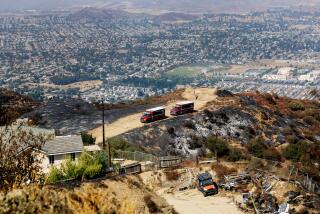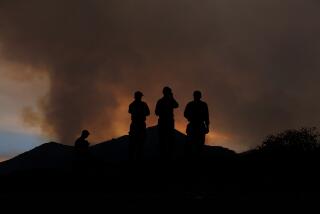Wildfire Continues to Burn Out of Control : Disaster: Backfires fail to halt blaze’s march through San Bernardino County mountains and desert. More than 60,000 acres have been consumed.
- Share via
FAWNSKIN, Calif. — Weary firefighters set raging backfires Wednesday in an effort to stem the advance of flames that have spread for five days through rugged mountain and desert terrain in San Bernardino County.
Despite their efforts, the West’s largest wildfire continued to expand after blackening more than 60,000 acres of chaparral and timber in the high desert and the San Bernardino Mountains. At least a dozen homes and 50 outbuildings have been damaged or destroyed.
The latest hot spot erupted Wednesday afternoon near the mountain town of Green Valley Lake, as burning pine trees sent flames shooting hundreds of feet.
Crew chiefs there used fire to fight fire--torching timber and chaparral to create a scorched-earth firebreak designed to stop the southerly advance of the flames.
“We’re going to try to beat it at its own game,” said Kathy Saindon, a spokeswoman for the more than 2,000 men and women battling the blaze.
Bob Gear, a sweating, soot-stained fire crewman from Benton County, Wash., said the struggle between the determined firefighters and the tenacious blaze was like some domestic disputes.
“It’s like having a teenager in the house,” he said. “You go back and forth, but eventually, one of you will end up in charge.”
Some residents of Green Valley Lake left town ahead of the approaching flames. Others chose to stay.
“I sent my wife down with the kids this afternoon, but I’m waiting until someone tells me I have to leave,” said Clint Bedley, who lives near the lake. During the day, erratic winds blew east, then west and then east again, fanning the flames in all directions and spreading smoke and haze from Pasadena to as far away as Las Vegas. At nightfall, the fire was only about 20% contained.
Earlier in the day, U.S. Forest Service officials had hoped that cooler temperatures and moist ocean air would help firefighters get the upper hand over the fire, which began last Saturday when an illegal campfire spread in a rugged area north of Lake Arrowhead.
Success in stemming the fire’s progress on its northern front was reported as firefighters blocked the flames’ advance across the Mojave Desert toward the communities of Apple Valley and Lucerne Valley. But in the mountains, where the so-called Willows fire still raged, containment proved difficult.
The flare-up occurred when tricky winds fanned flames that jumped Holcomb Creek and moved south to Green Valley Lake.
Firefighters, some of whom had been on the lines for five days, were rushed in to set the backfires.
“We’ve bucked fires before, and we’ll buck this one,” said Marvin Neville, 58, a firefighter and Green Valley Lake resident.
He was confident that backfires would keep the Willows fire from the town, which is between Lake Arrowhead and Big Bear Lake.
“Because of the winds, the flames kept jumping over the line, but things finally started to lie down about 8 p.m.,” said Tom Marshall, a crewman with the San Bernardino County Fire Department who was assigned to Green Valley Lake.
During the night, the backfires appeared to be doing their job, and although the Willows fire still burned out of control, there were no reports of more homes lost.
In Los Angeles County, the cooler temperatures and the moist ocean air aided the 800 firefighters battling a smaller wildfire above Glendora in San Gabriel Canyon.
The 7,000-acre blaze, dubbed the Bridge fire, was 15% contained Wednesday evening.
“The marine layer is cooling things down,” U.S. Forest Service spokeswoman Randi Jorgensen said.
Meanwhile, President Clinton declared an emergency in four Northern California counties--Butte, Shasta, Tehama and Tuolumne--because of large fires there, ordering federal aid to supplement state and local efforts.
One cluster of fires burned nearly 25,000 acres in the Shasta-Trinity area. A 12,000-acre fire was burning in Plumas National Forest. A 34,000-acre fire in Modoc National Forest was contained late Tuesday.
Firefighters from as far away as New England were brought in to fight the Willows fire, many of them landing at Ontario International Airport.
Mountain roads were busy as night fell Wednesday. Trucks carrying fresh personnel lumbered up to staging areas near Fawnskin, as cars loaded with evacuees and their belongings headed down from Green Valley Lake and other threatened hamlets.
Fourteen helicopters and eight air tankers were part of the resources used to fight the blaze.
Among the firefighters were about 200 state and county inmates, scores of Native Americans who contract out with the forest service for firefighting duties and full-time firefighters from throughout the United States. The caterer providing the scrambled-egg breakfasts, roast-beef-sandwich lunches and steak-and-pork-chop dinners came from Oregon.
The firefighters, who are working 12-hour shifts, are based out of a camp at the Snow Valley ski resort near Big Bear Lake.
By Wednesday night, the Willows fire had become the largest fire in the history of the San Bernardino Mountains. In 1970, cold, 80-mph November winds drove a fire through 56,000 acres in what became known as the Big Bear fire; in 1980, the so-called Panorama fire burned 23,000 acres and destroyed more than 350 homes.
When the Willows blaze broke out Saturday afternoon, firefighters’ immediate concern was that winds would drive it north, down the mountain slopes and into desert vegetation between the mountains and communities of Apple Valley and Lucerne Valley.
With too few firefighters available to create fire lines to stop the blaze--most of the state’s fire-fighting resources at the time were battling blazes to the north--immediate efforts were in protecting scores of scattered buildings and dwellings, some of them decades old. The fire moved across the desert floor, jumping from shrub to shrub but leaving few reminders of its presence.
“We went in the next day, and we could hardly find where the fire was, because the wind had blown the leaves away and all that was left was sand,” said forestry official Steve Jennison.
On Sunday, concern grew that the fire was turning back toward its point of origin and could threaten resort communities in the San Bernardino Mountains, like Green Valley Lake. Firefighters then turned much of their efforts there.
By Wednesday, firefighting strategists began igniting backfires between the main fire area and the mountain resort communities.
Although smoke from the blaze reached Nevada, Jennifer Sizemore, a spokeswoman for the Clark County Health District, said air pollution levels, which were within good-health limits Tuesday and Wednesday, had not been affected by the blaze.
McCarran International Airport in Las Vegas, which handles about 800 jetliner flights daily, reported no visibility problems with the smoky haze.
While the inferno has been responsible for spectacular scenes of flames and smoke, experts said the wildfire is part of the natural cycle of life in the desert and the mountains. Ashes from burned plants help bring back to life desert plants and flowers.
“We’re disturbed when people, structures and lives are affected,” said Elden Hughes of Whittier, chairman of the Sierra Club’s California Desert Committee. “But basically, mountains don’t burn often enough. They should burn about every 12 years to use up some fuel. Ideally, that’s how you build a fireproof forest . . . one that burns but doesn’t get hurt.”
Scott Eliason, a botanist with the National Forest Service at Fawnskin, said three different endangered plant species, found only in these mountains, may be jeopardized--not by the fire itself, but by being crushed by firefighters, hoses and bulldozers.
The plants include the Cushenbury buckwheat, a small perennial shrub with pink flowers; the Cushenbury oxytheca, a small annual herb, and the Cushenbury milk vetch, a perennial herb with flowers that look like sweet pea pods.
Those plants, along with the Parish’s daisy, a threatened daisy-like flower, grow only in the kind of limestone soil found on the San Bernardino mountains’ northern slopes, Eliason said.
Times staff writers Eric Malnic and Duane Noriyuki and the Associated Press contributed to this story.
* FIRE ENDANGERS TOURISM
A wildfire near Big Bear has scared away tourists and caused concern among merchants. B1
More to Read
Sign up for Essential California
The most important California stories and recommendations in your inbox every morning.
You may occasionally receive promotional content from the Los Angeles Times.













